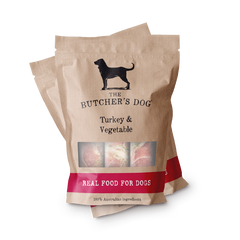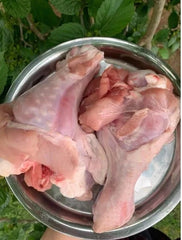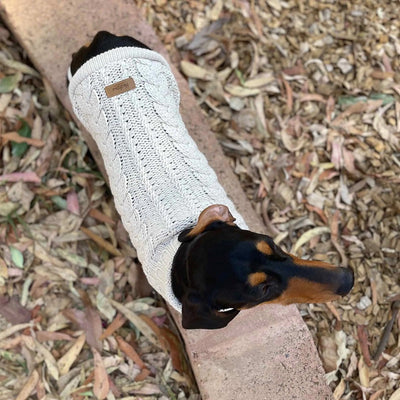Are you considering switching your dog to a raw feeding diet but not sure where to start? Look no further – this beginner’s guide will provide you with a step-by-step approach for optimal nutrition and health. We can see from our in store customers that raw feeding is gaining popularity among dog owners who want to provide their dog with a more natural and nutrient-rich diet.
In this guide, we will walk you through the basics of raw feeding, including the benefits, the types of meat and ingredients to include, and how to properly balance your dog’s meals. We will debunk common myths surrounding raw feeding and address any concerns you may have.
By adopting a raw feeding diet for your dog, you can expect to see improvements in their overall health, including a shinier coat, healthier teeth and gums, increased energy, improved digestion, and reduced allergies.
Whether you are a new dog owner or have been considering raw feeding for a while, this guide will provide you with all the information you need to make an informed decision and give your furry friend the best possible nutrition for a life of optimal health.
What is raw feeding for dogs
Raw feeding, also known as a raw diet or a Biologically Appropriate Raw Food (BARF) diet, involves feeding dogs a combination of raw meats, bones, fruits, and vegetables. This approach aims to mimic the diet of dogs' wild ancestors, who would consume raw prey in their natural habitat. Advocates of raw feeding believe that it provides dogs with a more natural and species-appropriate diet, leading to improved overall health and well-being.
The raw feeding diet typically consists of raw muscle meat, organ meat, bones, fruits, and vegetables. These ingredients can be sourced from a variety of animal sources, including beef, chicken, lamb, and fish. It is important to note that raw feeding does not involve cooking or processing the ingredients, as heat can destroy essential nutrients and enzymes.
Proponents of raw feeding argue that this diet provides numerous benefits for dogs, including improved digestion, reduced allergies, healthier skin and coat, stronger immune system, and better dental health. However, it is crucial to understand the nutritional needs of dogs and ensure a balanced diet to avoid any potential deficiencies or health issues.
Benefits of raw feeding for dogs in Australia
There are several benefits associated with feeding your dog a raw diet. One of the most noticeable improvements is often seen in their coat. Raw feeding can help promote a shinier and healthier coat due to the high levels of essential fatty acids found in raw meat. These fatty acids, such as omega-3 and omega-6, are essential for maintaining healthy skin and a lustrous coat.
In addition to a healthier coat, raw feeding can also improve your dog's dental health. Chewing on raw bones can help remove plaque and tartar buildup, leading to healthier teeth and gums. This natural dental care can reduce the risk of periodontal disease, a common problem among dogs.
Furthermore, raw feeding can boost your dog's energy levels and improve their overall vitality. The natural enzymes present in raw food can aid in digestion and absorption of nutrients, leading to increased energy and better nutrient uptake. Many dog owners report that their dogs have more stamina and vitality after switching to a raw diet.
Another significant advantage of raw feeding is its potential to reduce allergies. Many commercial dog foods contain fillers, artificial additives, and potential allergens that can trigger allergic reactions in dogs. By eliminating these ingredients and providing a natural, species-appropriate diet, raw feeding can help alleviate allergies and sensitivities in dogs.
Common misconceptions about raw feeding
Despite its growing popularity, raw feeding for dogs is still subject to many misconceptions and myths. One common misconception is that raw feeding is unsafe due to the risk of bacterial contamination. While it is true that raw meat carries a higher risk of bacterial contamination compared to cooked meat, proper handling and hygiene practices can mitigate this risk. Ensuring that the raw food is sourced from reputable suppliers and following safe handling guidelines can minimize the chances of bacterial infections.
Another myth surrounding raw feeding is that it is nutritionally imbalanced and can lead to deficiencies. While it is essential to provide a balanced and varied diet, raw feeding can provide dogs with all the necessary nutrients they need. By including a variety of meat, organs, bones, fruits, and vegetables in your dog's diet, you can ensure they receive a wide array of essential vitamins, minerals, and amino acids.
It is also important to dispel the notion that raw feeding is time-consuming and expensive. While it does require some planning and preparation, raw feeding can be cost-effective in the long run. By buying ingredients in bulk and using local sources, you can reduce costs and ensure a steady supply of fresh and high-quality ingredients for your dog's meals.
Understanding a dog's nutritional needs
Before embarking on a raw feeding journey, it is crucial to understand the nutritional needs of dogs. Dogs are omnivores with specific dietary requirements that include a balance of proteins, fats, carbohydrates, vitamins, and minerals. The proportions of these nutrients can vary depending on factors such as age, activity level, and overall health.
Protein is the most crucial component of a dog's diet, as it provides essential amino acids necessary for muscle development, repair, and overall growth. Raw feeding often relies on meat as the primary source of protein, which can be obtained from various animal sources such as beef, chicken, lamb, and fish. Including a variety of protein sources can help ensure a well-rounded diet for your dog.
Fats, specifically omega-3 and omega-6 fatty acids, are essential for a dog's overall health. These fatty acids play a vital role in maintaining healthy skin and coat, supporting brain function, and reducing inflammation. Raw feeding can provide dogs with a natural and balanced ratio of these essential fatty acids, contributing to their overall well-being.
Carbohydrates are not a necessary component of a dog's diet, as they can derive energy from proteins and fats. However, some dog owners choose to include carbohydrates in their dog's raw diet to provide additional energy and fiber. Fruits and vegetables can be added in small amounts to provide essential vitamins, minerals, and antioxidants.
Vitamins and minerals are essential for various bodily functions, including immune system support, bone health, and cell function. While raw feeding can provide many of these nutrients naturally, it is important to ensure a varied and balanced diet to prevent any deficiencies. Including a variety of fruits, vegetables, and organ meats can help meet these nutritional needs.
Transitioning to a raw diet: Step-by-step guide
Transitioning your dog to a raw diet requires a gradual approach to prevent any digestive upset. Here's a step-by-step guide to help you make the transition smoothly:
Step 1: Research and consult with your vet
Before making any changes to your dog's diet, it's important to do your research and consult with your veterinarian. They can provide guidance specific to your dog's needs and help you make an informed decision.
Step 2: Start with one protein source
Begin by introducing a single protein source such as chicken, beef, or turkey. This allows you to gauge your dog's tolerance and any potential allergies or sensitivities. Start with small portions and gradually increase the amount over a few days.
Step 3: Add in fruits and vegetables
Once your dog has adjusted to the new protein source, you can start adding in fruits and vegetables to provide additional nutrients and fiber. Some popular choices include carrots, apples, spinach, and sweet potatoes. Make sure to chop or puree them for easy digestion.
Step 4: Incorporate organ meats and bones
Organ meats like liver and kidneys are essential for a balanced raw diet as they provide important vitamins and minerals. Additionally, raw bones can help clean your dog's teeth and provide mental stimulation. Always ensure the bones are raw and suitable for your dog's size and breed.
Step 5: Monitor your dog's health and adjust as needed
Throughout the transition process, closely observe your dog's overall health, energy levels, and stool quality. If you notice any adverse reactions or changes, consult with your vet and make adjustments accordingly. Every dog is unique, so it's important to tailor their diet to their specific needs.
Transitioning to a raw diet may take some time and patience, but with the right approach, you can provide your dog with a nutritionally balanced and wholesome diet.
Our top raw dog food meals to feed your dog in Australia
While you can prepare your own raw meals for your dog, we recommend using prepared meals to ensure balanced and nutritionally sound meals for your four legged friend! Below is a list of the best premium raw meals for dogs according to what our customers have purchased.
Right Start Pet Food Meals: The range of raw dog food from Right Start Pet Foods is a comprehensive premium food range that uses human grade ingredients. We especially love their nutritious range of salmon heads, salmon bellies, turkey drumsticks and bone broth. Their new range of prepare meals include duck, roo, turkey and beef. These all make a delicious addition to pet owners who mix feed or like to treat their pets with healthy meal toppers!
Foods is a comprehensive premium food range that uses human grade ingredients. We especially love their nutritious range of salmon heads, salmon bellies, turkey drumsticks and bone broth. Their new range of prepare meals include duck, roo, turkey and beef. These all make a delicious addition to pet owners who mix feed or like to treat their pets with healthy meal toppers!
 The Butcher's Dog: The The Butcher's Dog range is free from preservatives, fillers, grains, and harmful chemicals. Each recipe has been developed in collaboration with Australian pet nutritionists, guaranteeing a well-balanced and nutritious meal for your pooch.
The Butcher's Dog: The The Butcher's Dog range is free from preservatives, fillers, grains, and harmful chemicals. Each recipe has been developed in collaboration with Australian pet nutritionists, guaranteeing a well-balanced and nutritious meal for your pooch.
This Aussie-made range includes all life stage formulas as well as a fruit, vegetable and organ supplement. You can also purchase their storage container that fits each disc and allows you to thaw safely in the fridge.
We all know how important chewing raw bones is for your dog's dental  health. Gum disease and plaque build up can be common for dogs that eat a raw diet. Regular checks are vital and providing them with plenty of fresh bones to chew can assist. Kangaroo tails and turkey drumsticks are Australian grown, human grade turkey thigh bones.
health. Gum disease and plaque build up can be common for dogs that eat a raw diet. Regular checks are vital and providing them with plenty of fresh bones to chew can assist. Kangaroo tails and turkey drumsticks are Australian grown, human grade turkey thigh bones.
The perfect raw bone for medium to large dogs.
Turkey is rich in amino acids, protein, calcium, glucosamine and is highly desirable for dogs with sensitivities.
Choosing the right ingredients for a balanced raw diet
When it comes to raw feeding, the quality and variety of ingredients are key to providing a balanced diet for your dog. Here are some tips for choosing the right ingredients if you are doing it yourself:
1. Select high-quality, human-grade meats
Opt for human-grade meats that are free from artificial additives, hormones, and antibiotics. Look for reputable sources that prioritise the welfare of the animals and follow proper food safety protocols.
2. Include a variety of proteins
To ensure your dog receives a wide range of nutrients, include a variety of protein sources in their diet. This can include chicken, beef, turkey, lamb, and fish. Rotating proteins can help prevent any potential allergies or sensitivities that may develop from feeding the same protein for an extended period.
3. Incorporate fruits and vegetables
Fruits and vegetables provide essential vitamins, minerals, and antioxidants. Aim to include a variety of colorful options such as carrots, blueberries, broccoli, and pumpkin. Remember to chop or puree them for easier digestion and maximum nutrient absorption.
4. Don't forget about organ meats
Organ meats are incredibly nutrient-dense and should make up a portion of your dog's raw diet. Liver, kidney, and heart are excellent choices as they are packed with essential vitamins and minerals. Start with small amounts and gradually increase the portion size.
5. Supplement with additional nutrients if necessary
While a well-balanced raw diet can provide most of the necessary nutrients, it's important to ensure your dog's diet is complete. Consider adding supplements such as omega-3 fatty acids, probiotics, and additional vitamins and minerals to ensure optimal nutrition.
Remember, it's crucial to consult with your veterinarian or a veterinary nutritionist to ensure your dog's specific dietary needs are met. They can provide guidance on portion sizes, specific nutrient requirements, and any additional supplements that may be necessary.
Raw feeding safety precautions
While raw feeding can provide numerous benefits, it's important to take certain safety precautions to reduce the risk of foodborne illness and ensure the health of your dog. Here are some safety tips to keep in mind:
1. Practice proper food handling and hygiene
When preparing raw meals, it's essential to practice good food hygiene. Wash your hands thoroughly before and after handling raw meat, clean all surfaces and utensils, and store raw ingredients separately from other foods to prevent cross-contamination.
2. Source ingredients from reputable suppliers
Make sure to source your raw ingredients from reputable suppliers that prioritize food safety and quality. Look for suppliers that follow strict handling and storage protocols and have a good track record of producing safe food.
3. Freeze raw meat to kill potential parasites
Raw meat can sometimes harbor parasites such as Toxoplasma gondii or Salmonella. Freezing the meat for a minimum of three weeks can help kill these parasites. However, it's important to note that freezing may not eliminate all potential pathogens, so proper handling and hygiene are still essential.
4. Monitor your dog's health and hygiene
Regularly monitor your dog's overall health, including their stool quality, energy levels, and coat condition. If you notice any changes or signs of illness, consult with your veterinarian promptly. Additionally, maintain good oral hygiene by regularly brushing your dog's teeth to prevent dental issues.
5. Be cautious with bones
While raw bones can be beneficial for dental health and mental stimulation, it's important to choose appropriate bones and supervise your dog during chewing. Avoid cooked bones, as they can splinter and cause choking or intestinal blockages. Always choose raw bones that are suitable for your dog's size and breed.
By following these safety precautions, you can reduce the risk of foodborne illness and ensure that raw feeding remains a safe and healthy option for your dog.
Raw feeding for dogs with specific health conditions
Raw feeding can be beneficial for dogs with specific health conditions. Here are some examples:
1. Allergies and food sensitivities
Many commercial dog foods contain common allergens such as grains, artificial additives, and fillers. Switching to a raw diet can help eliminate these potential triggers and alleviate symptoms of allergies and food sensitivities. By carefully selecting hypoallergenic proteins and avoiding common allergens, you can provide relief for your dog.
2. Digestive issues
Raw feeding can help improve digestive health in dogs with sensitive stomachs or chronic digestive issues. The high moisture content and natural enzymes in raw food can aid in digestion and relieve symptoms such as diarrhea, constipation, and flatulence.
3. Dental health
Chewing on raw bones can help improve dental health by removing plaque and tartar buildup. The natural chewing action also strengthens jaw muscles and reduces the risk of dental diseases such as gum inflammation and tooth decay.
4. Weight management
Raw feeding allows you to have better control over your dog's diet, making it easier to manage their weight. By providing portioned meals and selecting leaner proteins, you can help your dog reach and maintain a healthy weight.
5. Joint and mobility issues
Certain proteins, such as fish and organ meats, contain omega-3 fatty acids and glucosamine, which are beneficial for joint health. Raw feeding can help reduce inflammation, improve mobility, and alleviate symptoms of arthritis in dogs.
While raw feeding can be beneficial for many dogs with specific health conditions, it's important to consult with your veterinarian before making any dietary changes. They can provide guidance specific to your dog's needs and ensure that raw feeding is appropriate for their condition.
Embracing the raw feeding lifestyle for your dog's wellbeing
Raw feeding offers numerous benefits, from improved overall health to increased energy and vitality. By following a step-by-step approach to transitioning, choosing the right ingredients, and practicing safety precautions, you can provide your dog with a nutritionally balanced and wholesome diet.
Remember, every dog is unique, so it's important to consult with your veterinarian to ensure your dog's specific dietary needs are met. They can provide guidance, monitor your dog's health, and make adjustments as needed.
Embrace the raw feeding lifestyle and give your furry friend the best possible nutrition for a life of optimal health. Your dog will thank you with wagging tails, boundless energy, and a lifetime of happiness.
© weknowpets 2024





